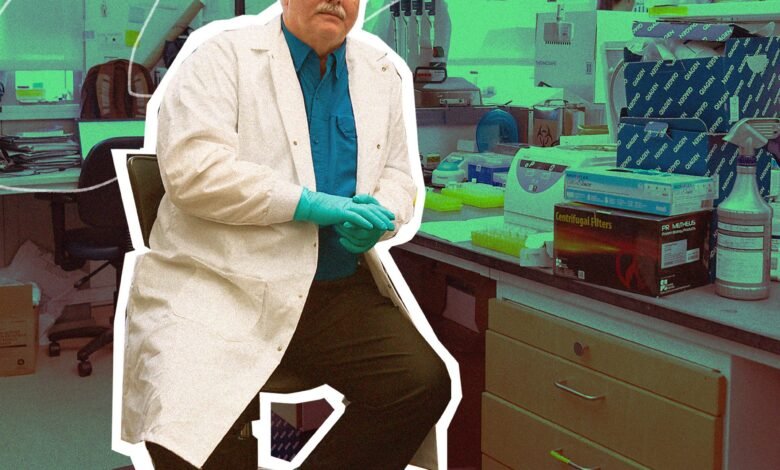Virologist Testified Lab Leak Was Possible in Wuhan: “You Can’t Rule That Out”

In 2015, Ralph S. Baric, arguably the world’s most accomplished coronavirologist, published groundbreaking research with Shi Zhengli, the leading coronavirus researcher at the Wuhan Institute of Virology.
They had mixed components of different coronaviruses and created an artificial virus, or chimera, that could infect human cells. The research helped crystallize the threat posed by bat coronaviruses lurking in nature. But the experiments were dangerous too. In 2014, while their research was underway, the Obama administration enacted a pause on so-called gain-of-function research that could increase the virulence or transmissibility of certain viruses. Baric and Shi even flagged the dangers of the research themselves, writing, “Scientific review panels may deem similar studies…too risky to pursue.”
The experiments were done in Baric’s well-secured laboratory in Chapel Hill, North Carolina. Afterward, however, Shi’s team at the WIV continued to utilize Baric’s cutting-edge research techniques. Their work was funded in part with a US research grant.
Amid competing theories about the origins of SARS-CoV-2, the virus that causes COVID-19—including whether it could have originated in a Wuhan laboratory—Baric has become a figure of intense interest. After all, he had pioneered techniques the WIV was using, including one that allows researchers to invisibly splice components of viruses together without leaving a trace.
For the last three years, as the COVID-19 origins debate has grown increasingly toxic, a small army of global sleuths and Freedom of Information petitioners have taken aim at Baric’s emails and research documents, hoping to uncover information about the true genetic-engineering capabilities of the WIV scientists, the ongoing research they were pursuing, and the viral genome sequences they had in their possession prior to the pandemic.
Through it all, Baric has kept mostly silent—until now. On January 22, he gave a six-hour interview to investigators from two Republican-led House committees: the Oversight and Accountability’s Select Subcommittee on the Coronavirus Pandemic, and Energy and Commerce’s Subcommittee on Oversight and Investigations. Though the committees have not yet made his testimony public, Vanity Fair has exclusively reviewed his statements. While not formally under oath, Baric was required by federal law to answer truthfully. (Through a University of North Carolina-Chapel Hill spokesperson, Baric declined to comment for this article.)
While there is little in the 212-page transcript that is likely to markedly shift the debate on how COVID-19 originated, the picture that emerges is of an American scientist who is deeply wary of his Chinese counterparts and has no way of knowing if or how they may have made use of the groundbreaking research techniques he developed.
Perhaps most notably, Baric testified that he had specifically warned Shi Zhengli that the WIV’s critical coronavirus research was being conducted in labs with insufficient biosafety protections. When he urged her to move the work to a more secure biosafety level 3 (BSL-3) lab, he testified that she did not heed his recommendation. Because the WIV continued to perform coronavirus research at what he considers an inappropriately low biosafety level, Baric said of a laboratory accident, “You can’t rule that out…. You just can’t.”
In an email turned over to the Select Subcommittee as part of its investigation, Baric told Peter Daszak, president of the scientific nonprofit EcoHealth Alliance, that it was “a load of BS” to suggest that the WIV conducted coronavirus research in labs with sufficient biosafety protocols.
Baric told congressional investigators that he believes it’s far more likely that SARS-CoV-2 spilled over naturally from animals to humans, given the sheer abundance of viruses in nature. But he also said in his testimony that he disagrees with the most widely promulgated spillover argument: that the virus leapt from infected animals to people at the Huanan Seafood Wholesale Market, where it first burst into public view in December 2019. The argument does not hold up, he said, because genomic evidence suggests that COVID-19 was already circulating in the human population by mid-to-late October. “Clearly, the market was a conduit for expansion,” he testified. “Is that where it started? I don’t think so.”
Baric also weighed in on a controversy that has pitted Dr. Anthony Fauci against Senator Rand Paul (R-KY), who has leveraged his credentials as an eye doctor to position himself as a crusader against America’s scientific and medical establishments. In contentious Senate hearings, Fauci has repeatedly denied Paul’s claims that the National Institute of Allergy and Infectious Diseases, which Fauci led at the time, had funded gain-of-function research at the WIV. However, Baric told investigators that the experiment in dispute, in which technicians created a chimeric virus that made lab mice sicker, was “absolutely” gain-of-function research: “You can’t argue with that.” He also said he felt that the experiment’s results should have triggered regulatory review.
The federal grant money for the experiment in question, which was conducted at the WIV sometime between 2018 and 2019, was funneled through EcoHealth Alliance. It was Daszak, EcoHealth’s president, who organized an open letter in the Lancet medical journal early in the pandemic that helped paint the lab-leak hypothesis as a baseless conspiracy theory. Today, the Select Subcommittee is expected to release a report that calls for NIH to recommend that EcoHealth Alliance, and Daszak personally, be debarred from receiving federal funds. As part of its investigation into COVID-19’s origins, the Select Subcommittee is holding a series of hearings. Daszak is scheduled to testify publicly today, and Fauci is set to do so on June 3.
America’s intelligence agencies remain divided over whether SARS-CoV-2 came from a natural spillover or a lab accident. US Health and Human Services Secretary Xavier Becerra recently said the question may “never” be answered “unless China opens up some more.”
The single biggest issue to jump from the pages of Baric’s testimony is his persistent concern over unsafe research practices at the WIV. Some of Shi’s research papers, he said, “actually stated that they were doing the culturing work under BSL-2.” BSL-3 labs typically require negative pressure air flow, HEPA air filtration systems, and full Tyvek suits for lab workers—all to protect against leaks. BSL-2 laboratories do not require specialized air filtration or full gowns.
Throughout his interview, Baric took pains to emphasize to congressional investigators that he had not simply turned over his research techniques to his colleagues at the WIV. Referring to his 2015 research with Shi, he said, “Although we published the approaches for how to build molecular clones of coronaviruses, we never had anyone from Dr. Shi’s lab or any of the Wuhan Institute of Virology come to our lab and train. We never taught them.”
His trust was violated on at least one occasion, he said. In order to test the ability of different viruses to infect humans, Baric had engineered mice with lungs that contained a human gene. He said he shared these mice with the WIV under a contractual agreement that they only be used there. Then, during the pandemic, he said he discovered that his mice were being offered for sale by a commercial company. The profiteering, he told investigators, was “infuriating.”
As Baric recounted to congressional investigators, Shi’s earlier work was “very vague about safety conditions. They said they followed Chinese regulations.” But in two subsequent papers, said Baric, “They actually stated that they were doing the culturing work under BSL-2…. And then they continued that even into September of 2020, which I thought was irresponsible.” (Neither Shi Zhengli nor a spokesperson for the Wuhan Institute of Virology responded to requests for comment.)
Baric told the committee that, from his earliest days working with zoonotic coronaviruses, he always understood there was a real if “rare” chance that one could prove infectious to humans. “And if that’s your hypothesis, then you do it under BSL-3,” he said. “So I kind of set the standard in the United States.”
But the WIV, he said, operated under a looser set of biosafety protocols. “Their regulations state pretty clearly that they don’t consider culturing bat viruses at BSL-2 as a biosafety concern,” he said. “I also had that verbally confirmed by Zhengli Shi at a meeting in Harbin, when I was telling her she should move it all to BSL-3 and the reasons why.” (Less than a year into the pandemic, the Chinese government passed legislation that tightened the nation’s laboratory safety practices.)
The dispute over biosafety arose again in 2018, as Baric and Shi worked with Daszak on a grant proposal to collect SARS-like bat coronaviruses and insert a genetic component called a furin cleavage site that would enable them to more easily infect human cells. The proposal has since drawn attention because, when SARS-CoV-2 subsequently emerged in Wuhan, it possessed a furin cleavage site, making it unique among SARS-related coronaviruses. The 2018 proposal was submitted by Daszak to the Pentagon research and development agency DARPA.
Last December, a Freedom of Information research group called U.S. Right to Know released margin comments from an early draft of the grant proposal. In one, Peter Daszak tagged his collaborators and said, “Ralph. Zhengli. If we win this contract, I do not propose that all of this work will necessarily be conducted by Ralph, but I do want to stress the US side of this proposal so that DARPA are comfortable with our team. Once we get the funds, we can then allocate who does what exact work, and I believe that a lot of these assays can be done in Wuhan as well.”
The early draft stipulated that the research would be done at a BSL-2 level, making it “highly cost-effective.” Baric objected to this in a margin comment of his own: “IN the US, these recombinant SARS CoV are studied under BSL3, not BSL2, especially important for those that are able to bind and replicate in primary human cells. In china, might be growin these virus under bsl2. US researchers will likely freak out.” In the finished proposal, BSL-2 was changed to BSL-3.
Baric told congressional investigators that he wrote the margin comment to Daszak “to make sure he pays attention.” He added, “First, I’m informing him, just in case he doesn’t know, that a lot of the virus discovery work and culturing work that the Chinese do with zoonotic coronaviruses is done at BSL-2…. I’m letting him know there’s a difference.”
After a congressional investigator observed, “It appears there may have been a willingness, not necessarily by you, to do some of this work in the BSL-2 in China,” Baric responded, “There was no willingness on my part to do any of this work…. Let me make that clear.” He subsequently clarified, “My role was to study a couple of the viruses that the Wuhan Institute of Virology found that they were willing to share with me.”
DARPA rejected the grant, but questions have persisted over whether WIV scientists carried out the proposed research anyway. Baric told congressional investigators that he doesn’t know whether the WIV continued the research or got other funding for it. He added that he does not believe SARS-CoV-2 was engineered and discounted a 2022 paper making that argument as “biostatistical BS.” Alex Washburne, one of the paper’s authors, told Vanity Fair, “Baric doesn’t provide any scientific evidence or reasoning that would lead us to revisit our results or change our theory.”
In May 2021, Baric signed an open letter in the journal Science affirming that the lab and natural origin hypotheses are both viable and calling for further investigation. A fellow scientist, Columbia University virologist Ian Lipkin, questioned him about why he signed the letter. In response, Baric told the subcommittee, “I sent him a couple of papers that the Chinese had published where they were doing virus discovery work under BSL-2 conditions, which is one of the main reasons why I felt that the potential laboratory escape hypothesis shouldn’t be, in essence, put under the rug.”
Baric’s signing of that letter also precipitated a testy email exchange with Daszak over the WIV’s safety standards, obtained by Vanity Fair. Daszak enumerated to Baric the various ways in which China’s lab safety standards did not lag far behind US standards. He added, “We checked with Zhengli, who let us know that she used ‘BSL-2 with negative pressure and appropriate PPE.’”
This brought a withering response from Baric. “Bsl2 with negative pressure, give me a break.” He pointed out that even Shi’s most recent papers never defined the safety precautions used. “Yes china has the right to set their own policy. You believe this was appropriate containment if you want but don’t expect me to believe it. Moreover, don’t insult my intelligence by trying to feed me this load of BS.”
Reached for comment, Daszak told Vanity Fair that the WIV performed its animal infection experiments “at BSL-3, as per work at Dr. Baric’s lab in the USA.” He also stated that the research rejected by DARPA was “never done,” and said that the proposal called for only work that “did not involve any infectious materials” to be done in a BSL-2 facility at the WIV. Regarding the Subcommittee’s call for the NIH to recommend debarring him and EcoHealth Alliance from receiving federal funds, he said he hadn’t yet seen the report and couldn’t comment on it. However, he stated that EcoHealth Alliance has “cooperated fully and expeditiously with the NIH on additional oversight measures since 2020” and shared a letter from last October in which the NIH deemed the nonprofit compliant with oversight requirements.
Another signatory to the May 2021 letter was Dr. Michael Worobey, who has since become a leading proponent of the theory that the virus spilled over from infected animals at the Huanan Seafood Wholesale Market.
In 2022, Worobey and a team of international scientists published an influential research paper that used a geospatial analysis of early infections in Wuhan to make a case for the market spillover theory. Using data collected by Chinese scientists, Worobey’s team later also published evidence in a preprint that virus-susceptible mammals, such as raccoon dogs, were present at the market.
When prominent virologists state that the preponderance of evidence points to a natural origin, they are often referring to Worobey’s research. Baric, for his part, told congressional investigators that Worobey’s geospatial study has a “major problem” with its timeline. He told the subcommittee, “The only thing we have really solid data [for] is that the market was the site of amplification in late December, January. That’s still two months from the origin date, based on a molecular clock, which means it was circulating somewhere before it got there. And the question is, where was it?”
Baric said the earliest cases are “almost impossible” to document because many were asymptomatic. “It’s a fundamental problem with the papers that are reported to prove—they write it too strong, I think, but they’re very passionate about their data. And to be fair to them, it is the best data that’s out there.” He went on to critique the papers’ claim of two independent jumps from different infected animals at the market based on the presence of two different lineages of the virus. “It’s a stretch,” he said, adding that his view is shared by “a lot of virologists that look at that data and go, mmm.”
Calling the evidence for a market origin “powerful,” Worobey told Vanity Fair that he thinks the first jump from animals to humans happened in November. Baric, he said, “possesses essentially no expertise in the subjects of the papers he is commenting on…. It is irresponsible for him to share these views with anyone without also making it clear that he is in no better position than the average educated person to judge this work.”
In his testimony, Baric was equivocal on the question of whether WIV scientists could have possessed SARS-CoV-2, or a very close progenitor, prior to the pandemic. There “was evidence that they were building chimeras” and “doing some discovery work about the functions of spike genes of zoonotic strains that they discovered later on, but I don’t know if they did any of the engineering or anything.”
Without further disclosure from China, the answer may be unknowable. As Baric told congressional investigators, “If you had access to the laboratory notebooks, if you had access to the safety records of the Wuhan Institute of Virology, if you had access to the sequence databases, the level of assurance that you would have would be greater. No question.”
“Which we didn’t really have?” a congressional investigator asked.
“Which we don’t really have,” Baric responded. “That’s very true.”
-
An Exclusive First Look at Francis Ford Coppola’s Megalopolis
-
Kristi Noem Doubles Down on Decision to Kill Family Dog




